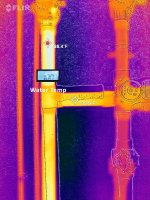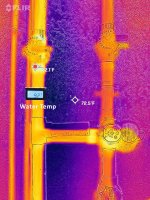- Sep 28, 2018
- 238
- Pool Size
- 13000
- Surface
- Plaster
- Chlorine
- Salt Water Generator
- SWG Type
- Pentair Intellichlor IC-40
EDIT [Source Code]:
https://www.dropbox.com/sh/k0feg94ucntjhgi/AACU6vqU088z4NSxl2gSLIFga?dl=0
TLDR: I've been thinking about the relationship between GPM and solar heat delivered to the pool and believe it to be more nuanced than the efficiency chart we've all seen. I put together a little variable speed solar controller using nodejsPC and python to regulate the pump depending on the solar temperature, with the goal of reducing cost with no lost efficiency when solar is heating the water less but while maximizing actual heat transfer when there's more heat on the roof. The first photo is the temperature of the solar return pipe and water temp with about 27-28 GPM (via flowvis) and the second is the temperature at around 45-46 GPM, with the roof sensor around 125 degrees:


Once we get into summer, this difference will be much more drastic with temperatures over 140.
The primary reason I did this is because my board's solar sensor terminals got damaged during Ian, so I had to change the solar valve to a regular actuator and just run the pump around 35GPM with solar on a 10am-sunset schedule. This became a problem when the solar started to get to 91, 92, and I realized I really NEEDED a way to regulate it. I also didn't like that I had solar on during cloudy/rainy times. The basic functionality was relatively easy to script in python thanks to the incredible work done by @tagyoureit and @rstrouse helping me here and on github. However, I thought it would be interesting to see how it would behave with a variable speed. So far, it's only 4 stepped speeds because there doesn't seem to yet be a way to change speed through the API and you only get 8 pump circuits - but it does the job fine enough until I can just send GPM directly through.
I've convinced myself it's both somewhat cheaper to run and provides more effective heating because:
I have the script currently logging each time it turns on/off and changes speed from 25, to 35, to 45, to 55, and have mapped the true cost to run the pump at each RPM with my multimeter, so I'm going to have the solar controller rotate every other day between variable and fixed solar, allowing me to estimate the cost and efficiency of each method for a while. Maybe it will be marginal - but it's interesting to me anyway.
https://www.dropbox.com/sh/k0feg94ucntjhgi/AACU6vqU088z4NSxl2gSLIFga?dl=0
TLDR: I've been thinking about the relationship between GPM and solar heat delivered to the pool and believe it to be more nuanced than the efficiency chart we've all seen. I put together a little variable speed solar controller using nodejsPC and python to regulate the pump depending on the solar temperature, with the goal of reducing cost with no lost efficiency when solar is heating the water less but while maximizing actual heat transfer when there's more heat on the roof. The first photo is the temperature of the solar return pipe and water temp with about 27-28 GPM (via flowvis) and the second is the temperature at around 45-46 GPM, with the roof sensor around 125 degrees:


Once we get into summer, this difference will be much more drastic with temperatures over 140.
The primary reason I did this is because my board's solar sensor terminals got damaged during Ian, so I had to change the solar valve to a regular actuator and just run the pump around 35GPM with solar on a 10am-sunset schedule. This became a problem when the solar started to get to 91, 92, and I realized I really NEEDED a way to regulate it. I also didn't like that I had solar on during cloudy/rainy times. The basic functionality was relatively easy to script in python thanks to the incredible work done by @tagyoureit and @rstrouse helping me here and on github. However, I thought it would be interesting to see how it would behave with a variable speed. So far, it's only 4 stepped speeds because there doesn't seem to yet be a way to change speed through the API and you only get 8 pump circuits - but it does the job fine enough until I can just send GPM directly through.
I've convinced myself it's both somewhat cheaper to run and provides more effective heating because:
- Even before the heat transfer itself is considered, the hotter the water is heated, the closer the water temperature is to the temperature of the heat source, reducing the efficiency of the actual heating going on in the pipes. Easy way for me to think about this was if I left the water in the panels on the roof for 30 minutes, as they approach their maximum temperature, let's say 150 degrees, the rate at which temperature increases goes down as it settles closer and closer to the maximum temperature as its asymptote.
- When the water is moving through the pipes off the roof and under ground, it is losing heat to the much relatively cooler environment. This effect is increased with a greater temperature differential between the heated water and the air or ground it moves through.
- When the temperature between the return water is already so much closer to the air/ground temp but still far from the solar temp, I don't see any way you're losing much heat by running it far slower to save money.
I have the script currently logging each time it turns on/off and changes speed from 25, to 35, to 45, to 55, and have mapped the true cost to run the pump at each RPM with my multimeter, so I'm going to have the solar controller rotate every other day between variable and fixed solar, allowing me to estimate the cost and efficiency of each method for a while. Maybe it will be marginal - but it's interesting to me anyway.
Last edited:

